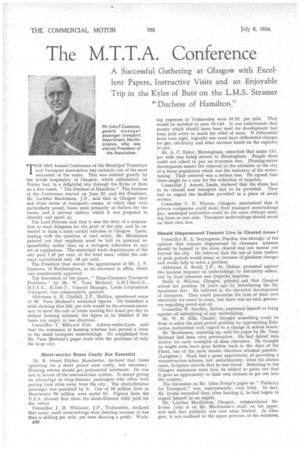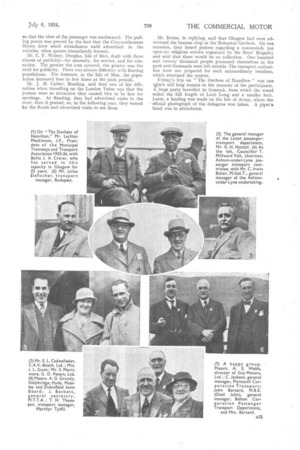The M.T.T.A, Conference
Page 48

Page 49

If you've noticed an error in this article please click here to report it so we can fix it.
A Successful Gathering at Glasgow with Excellent Papers, Instructive Visits and an Enjoyable Trip in the Kyles of Bute on the L.M.S. Steamer "Duchess of Hamilton,"
THE 33rd Annual Conference of the Municipal Tramways and Transport Association was certainly one of the most successful of the series. This was assisted greatly by the lavish hospitality of Glasgow, which culminated, on Friday last, in a delightful trip through the Kyles of Bute on a fine vessel, "The Duchess of Hamilton." The business of the Conference started on June 27, and the President, Mr. Lachlan Mackinncm, J.P., said that in Glasgow they had three forms of transport—trams, of which they were particularly•proud, buses used primarily as feeders for the trams, and a subway railway which it was proposed to electrify and speed up.
The Lord Provost said that it was the duty of a corporation to send delegates for the good of the city, and he extended to them a most cordial welcome to Glasgow. Later, dealing with the question of road safety, Mr. Mackinnon pointed out that emphasis must be laid on personal responsibility rather than on a stringent adherence to any set of regulations. The municipal trade departments of the city paid 7.47 per cent. of the total rates, whilst the railways contributed only .56 per cent.
The President then moved the appointment of Mr. J. F. Cameron, of Northampton, as his successor in office, which was unanimously approved.
The discussion on the paper, "Slum-Clearance Transport Problems," by Mr. W. Vane Alorland, A.M.I.Mech.E., M.I. A .E., M.Inst.T.,. General Manager, Leeds Corporation Transport, was commendably spirited.
Alderman A. H. Gledhill, J.P., Halifax, questioned some of Mr. Vane Morland's estimated figures. He furnished a, table showing that 24d. per mile would be the revenue necessary to meet the cost of buses running five hours per day to distant housing schemes, the figure to be doubled if the buses ran empty in one direction.
Councillor T. Millward Fish, Ashton-under-Lyne, said that the extension of housing schemes had proved a boon to the small transport undertakings. He complained that Mr, Vane Morland's paper dealt with the problems of only the large city.
Short-service Buses Costly But Essential Mr. R. Stuart Pilcher, Manchester, declared that buses operating for a short period were costly, but necessary. Housing estates should get preferential treatment. He was not in favour of the universal-fare system. It meant giving an advantage to long-distance passengers who often were paying their rates away from the city. The short-distance passenger was penalised by it. Out of 93 million fares in Manchester 70 million were under 2d. Figuresfrom the U.S.A. showed that there the short-distance rider paid for the others
Councillor j. H. Whitaker, J.P., Todmorden; declared that many small undertakings were drawing revenue of less than a shilling per mile, yet were showing a profit. Work
1330 ing expenses at Todmorden were 10.7d. per mile. They would be satisfied to earn 13-14d. It was unfortunate that money which should have been used for development had been paid away so much for relief of rates. If differential fares were right, logically one must have differential charges for gas, electricity and other services based on the capacity to pay.
Mr. A. C. Baker, Birmingham, remarked that under lid. ' per mile was being earned in Birmingham. People there could not afford to pay an economic fare. Housing-estate development meant the removal to the outskirts of the city of a dense population which was the mainstay of the undertaking. Their removal was a serious loss. He agreed that there might be a case for the reduction of taxation.
Councillor J. Arnott, Leeds, declared that the slums had to be cleared and transport had to be provided. They had to regard the facilities provided as a piece of social service. .
Councillor V. D. Warren, Glasgow, maintained that if private companies could make their transport undertakings pay, municipal authorities could do the same without needing State or rate aids. Transport undertakings should stand on their own feet.
Should Dispossessed Tenants Live in Cleared Areas ?
Councillor R. A. Scrymgeour, Dundee, was strongly of the opinion that tenants dispossessed by clearance schemes should be housed in the areas cleared and not moved out beyond the city.. He believed that the use of tram trailers at peak periods would mean no increase of platform charges and would help to solve a problem.
Alderman A. Rudd, J.P., St. Helens, protested against the burdens imposed on undertakings by electricity sellers. and by local assessors and Imperial taxation.
Bailie A. McLean, Glasgow, pointed out that Glasgow solved her problem 13 years ago by introducing the 2d. maximum fare. He believed in the electrical development of transport. They could guarantee the cost of their own electricity for years to come, but there was no such guaran
tee regarding petrol and oil, • • Councillor W. Bradley, Bolton, expressed himself as being against all subsidizing of any undertaking Mr. W. H. Ellis, Chester, thought something could be done to solve the peak-period problem by approaching Education Authorities with regard to a change in school hours.
Mr. Mackinnon, summing up, said the paper by Mr. Vane Morland had been very provocative. He had delved into history for early examples of slum clearance. He thought he might even have gone farther back to the days of the Flood, one of the most drastic clearance schemes possible. (Laughter.) Noah had a great opportunity of providing a reconstruction scheme, but, unfortunately, when his chance came, Scripture records that he was drunk. Referring to the Glasgow maximum tram fare, he wished to point out that it gave an opportunity to their own citizens to get out into the country, . The discussion on Mr. Allan Irvine's paper on "Publicity for Transport," was, unfortunately, very brief. In fact, Mr. Irvine remarked that, after hearing it, he had begun to regard himself a.s an expert. Mr. Lachlan Mackinnon, Glasgow, congratulated Mr. Irvine (who is on Mi. Mackinnon's staff) on his paper, and said that publicitY Was best when limited. In Glasgow, it was confined to the upper portions of the windows, so that the view of the passenger was unobscured. The pulling power was proved by the fact that the Chrysanthemum Shows drew small attendances until advertised in the vehicles, when queues immediately formed.
Mr. C. F. Wolsey, Douglas, Isle of Man, dealt with three classes of publicity—for necessity, for service, and for education. The greater the area covered, the greater was the need for publicity. There was always difficulty with floating populations. For instance, in the Isle of Man, the population increased four to five times at the peak periods. Mr. J. M. Calder, Reading, said that one of his difficulties when travelling on the London Tubes was that the posters were so attractive they caused him to be late for meetings. At Reading, they had advertised visits to the river, then it poured, so, in the following year, they waited for the floods and advertised visits to see them. Mr. Irvine, in replying, said that Glasgow had even advertised the banana crop at the Botanical Gardens. On one occasion, they issued posters regarding a conventicle (an open-air religious service organized by the Boys' Brigade) and said that there would be no collection. One hundred and twenty thousand people presented themselves in the park and thousands were left outside. The transport authorities were not prepared for such extraordinary numbers, which swamped the system.
Friday's trip on " The Duchess of Hamilton "• was one vAllich will long remain in the memory of the participants. A large party travelled to Gourock, from which the vessel sailed the full length of Loch Long and a smaller loch. Later, a landing was made on the Isle of Arran, where the official photograph of the delegates was taken. A piper's band was in attendance.




































































































